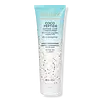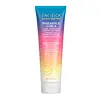What's inside
What's inside
 Key Ingredients
Key Ingredients

 Benefits
Benefits

 Concerns
Concerns

 Ingredients Side-by-side
Ingredients Side-by-side

Water
Skin ConditioningAloe Barbadensis Leaf Juice
Skin ConditioningCetyl Alcohol
EmollientStearyl Alcohol
EmollientPPG-3 Benzyl Ether Myristate
EmollientCetrimonium Chloride
AntimicrobialPrunus Armeniaca Kernel Oil
MaskingLens Esculenta Seed Extract
Skin ProtectingHydrolyzed Cicer Seed Extract
Skin ProtectingChenopodium Quinoa Seed Extract
Skin ConditioningDiheptyl Succinate
EmollientCapryloyl Glycerin/Sebacic Acid Copolymer
Skin ConditioningHydrogenated Castor Oil/Sebacic Acid Copolymer
EmollientStearamidopropyl Dimethylamine
EmulsifyingBehentrimonium Methosulfate
Cetearyl Alcohol
EmollientSr-Hydrozoan Polypeptide-1
HumectantCopper Tripeptide-1
Skin ConditioningCaffeine
Skin ConditioningBiotin
AntiseborrhoeicCocos Nucifera Water
MaskingGlycerin
HumectantCocos Nucifera Fruit Juice
EmollientPanax Ginseng Root Extract
EmollientCocos Nucifera Oil
MaskingAmaranthus Caudatus Seed Extract
Skin ConditioningCaramel
Cosmetic ColorantParfum
MaskingTocopherol
AntioxidantPanthenol
Skin ConditioningCitric Acid
BufferingPotassium Sorbate
PreservativeSodium Benzoate
MaskingEthylhexylglycerin
Skin ConditioningWater, Aloe Barbadensis Leaf Juice, Cetyl Alcohol, Stearyl Alcohol, PPG-3 Benzyl Ether Myristate, Cetrimonium Chloride, Prunus Armeniaca Kernel Oil, Lens Esculenta Seed Extract, Hydrolyzed Cicer Seed Extract, Chenopodium Quinoa Seed Extract, Diheptyl Succinate, Capryloyl Glycerin/Sebacic Acid Copolymer, Hydrogenated Castor Oil/Sebacic Acid Copolymer, Stearamidopropyl Dimethylamine, Behentrimonium Methosulfate, Cetearyl Alcohol, Sr-Hydrozoan Polypeptide-1, Copper Tripeptide-1, Caffeine, Biotin, Cocos Nucifera Water, Glycerin, Cocos Nucifera Fruit Juice, Panax Ginseng Root Extract, Cocos Nucifera Oil, Amaranthus Caudatus Seed Extract, Caramel, Parfum, Tocopherol, Panthenol, Citric Acid, Potassium Sorbate, Sodium Benzoate, Ethylhexylglycerin
Water
Skin ConditioningCetrimonium Chloride
AntimicrobialCetyl Alcohol
EmollientSorbitol
HumectantCaprylic/Capric Triglyceride
MaskingAnanas Sativus Fruit Extract
Skin ConditioningHelianthus Annuus Seed Oil
EmollientBehentrimonium Methosulfate
Cetearyl Alcohol
EmollientPanthenol
Skin ConditioningTocopherol
AntioxidantChamomilla Recutita Flower
Skin ConditioningRubus Idaeus Fruit Extract
AstringentStearamidopropyl Dimethylamine
EmulsifyingEmulsifying Wax Nf
Simmondsia Chinensis Seed Oil
EmollientLecithin
EmollientHyaluronic Acid
HumectantHydrolyzed Soy Protein
HumectantPotassium Sorbate
PreservativeSodium Benzoate
MaskingEthylhexylglycerin
Skin ConditioningParfum
MaskingWater, Cetrimonium Chloride, Cetyl Alcohol, Sorbitol, Caprylic/Capric Triglyceride, Ananas Sativus Fruit Extract, Helianthus Annuus Seed Oil, Behentrimonium Methosulfate, Cetearyl Alcohol, Panthenol, Tocopherol, Chamomilla Recutita Flower, Rubus Idaeus Fruit Extract, Stearamidopropyl Dimethylamine, Emulsifying Wax Nf, Simmondsia Chinensis Seed Oil, Lecithin, Hyaluronic Acid, Hydrolyzed Soy Protein, Potassium Sorbate, Sodium Benzoate, Ethylhexylglycerin, Parfum
Ingredients Explained
These ingredients are found in both products.
Ingredients higher up in an ingredient list are typically present in a larger amount.
Behentrimonium Methosulfate is an ammonium salt. It is mainly used to prevent static in haircare products as a surfactant.
Surfactants have differing ends: one side is hydrophilic while the other end is hydrophobic.
Surfactants also help your cleansers remove pollutants more easily from the skin.
Learn more about Behentrimonium MethosulfateCetearyl alcohol is a mixture of two fatty alcohols: cetyl alcohol and stearyl alcohol. It is mainly used as an emulsifier. Emulsifiers help prevent the separation of oils and products. Due to its composition, it can also be used to thicken a product or help create foam.
Cetearyl alcohol is an emollient. Emollients help soothe and hydrate the skin by trapping moisture.
Studies show Cetearyl alcohol is non-toxic and non-irritating. The FDA allows products labeled "alcohol-free" to have fatty alcohols.
This ingredient is usually derived from plant oils such as palm, vegetable, or coconut oils. There is debate on whether this ingredient will cause acne.
Due to the fatty acid base, this ingredient may not be Malassezia folliculitis safe.
Learn more about Cetearyl AlcoholThis ingredient is a preservative, antimicrobial, and emulsifier. It is often used in cosmetics for its ability to cleanse, condition, and reduce static.
Cetrimonium chloride is a quaternary ammonium salt, meaning it has a water-soluble structure.
Cetyl Alcohol is a fatty alcohol. Fatty Alcohols are most often used as an emollient or to thicken a product.
Its main roles are:
Though it has "alcohol" in the name, it is not related to denatured alcohol or ethyl alcohol.
The FDA allows products labeled "alcohol-free" to have fatty alcohols.
Learn more about Cetyl AlcoholEthylhexylglycerin (we can't pronounce this either) is commonly used as a preservative and skin softener. It is derived from glyceryl.
You might see Ethylhexylglycerin often paired with other preservatives such as phenoxyethanol. Ethylhexylglycerin has been found to increase the effectiveness of these other preservatives.
Panthenol is a common ingredient that helps hydrate and soothe the skin. It is found naturally in our skin and hair.
There are two forms of panthenol: D and L.
D-panthenol is also known as dexpanthenol. Most cosmetics use dexpanthenol or a mixture of D and L-panthenol.
Panthenol is famous due to its ability to go deeper into the skin's layers. Using this ingredient has numerous pros (and no cons):
Like hyaluronic acid, panthenol is a humectant. Humectants are able to bind and hold large amounts of water to keep skin hydrated.
This ingredient works well for wound healing. It works by increasing tissue in the wound and helps close open wounds.
Once oxidized, panthenol converts to pantothenic acid. Panthothenic acid is found in all living cells.
This ingredient is also referred to as pro-vitamin B5.
Learn more about PanthenolParfum is a catch-all term for an ingredient or more that is used to give a scent to products.
Also called "fragrance", this ingredient can be a blend of hundreds of chemicals or plant oils. This means every product with "fragrance" or "parfum" in the ingredients list is a different mixture.
For instance, Habanolide is a proprietary trade name for a specific aroma chemical. When used as a fragrance ingredient in cosmetics, most aroma chemicals fall under the broad labeling category of “FRAGRANCE” or “PARFUM” according to EU and US regulations.
The term 'parfum' or 'fragrance' is not regulated in many countries. In many cases, it is up to the brand to define this term.
For instance, many brands choose to label themselves as "fragrance-free" because they are not using synthetic fragrances. However, their products may still contain ingredients such as essential oils that are considered a fragrance by INCI standards.
One example is Calendula flower extract. Calendula is an essential oil that still imparts a scent or 'fragrance'.
Depending on the blend, the ingredients in the mixture can cause allergies and sensitivities on the skin. Some ingredients that are known EU allergens include linalool and citronellol.
Parfum can also be used to mask or cover an unpleasant scent.
The bottom line is: not all fragrances/parfum/ingredients are created equally. If you are worried about fragrances, we recommend taking a closer look at an ingredient. And of course, we always recommend speaking with a professional.
Learn more about ParfumPotassium Sorbate is a preservative used to prevent yeast and mold in products. It is commonly found in both cosmetic and food products.
This ingredient comes from potassium salt derived from sorbic acid. Sorbic acid is a natural antibiotic and effective against fungus.
Both potassium sorbate and sorbic acid can be found in baked goods, cheeses, dried meats, dried fruit, ice cream, pickles, wine, yogurt, and more.
You'll often find this ingredient used with other preservatives.
Learn more about Potassium SorbateSodium Benzoate is a preservative. It's used in both cosmetic and food products to inhibit the growth of mold and bacteria. It is typically produced synthetically.
Both the US FDA and EU Health Committee have approved the use of sodium benzoate. In the US, levels of 0.1% (of the total product) are allowed.
Sodium benzoate works as a preservative by inhibiting the growth of bacteria inside of cells. It prevents the cell from fermenting a type of sugar using an enzyme called phosphofructokinase.
It is the salt of benzoic acid. Foods containing sodium benzoate include soda, salad dressings, condiments, fruit juices, wines, and snack foods.
Studies for using ascorbic acid and sodium benzoate in cosmetics are lacking, especially in skincare routines with multiple steps.
We always recommend speaking with a professional, such as a dermatologist, if you have any concerns.
Learn more about Sodium BenzoateWe don't have a description for Stearamidopropyl Dimethylamine yet.
Tocopherol (also known as Vitamin E) is a common antioxidant used to help protect the skin from free-radicals and strengthen the skin barrier. It's also fat soluble - this means our skin is great at absorbing it.
Vitamin E also helps keep your natural skin lipids healthy. Your lipid skin barrier naturally consists of lipids, ceramides, and fatty acids. Vitamin E offers extra protection for your skin’s lipid barrier, keeping your skin healthy and nourished.
Another benefit is a bit of UV protection. Vitamin E helps reduce the damage caused by UVB rays. (It should not replace your sunscreen). Combining it with Vitamin C can decrease sunburned cells and hyperpigmentation after UV exposure.
You might have noticed Vitamin E + C often paired together. This is because it is great at stabilizing Vitamin C. Using the two together helps increase the effectiveness of both ingredients.
There are often claims that Vitamin E can reduce/prevent scarring, but these claims haven't been confirmed by scientific research.
Learn more about TocopherolWater. It's the most common cosmetic ingredient of all. You'll usually see it at the top of ingredient lists, meaning that it makes up the largest part of the product.
So why is it so popular? Water most often acts as a solvent - this means that it helps dissolve other ingredients into the formulation.
You'll also recognize water as that liquid we all need to stay alive. If you see this, drink a glass of water. Stay hydrated!
Learn more about Water